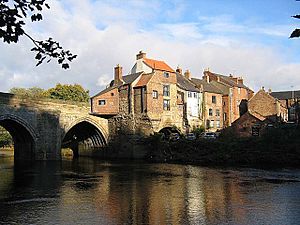Elvet facts for kids
Quick facts for kids Elvet |
|
|---|---|
 Old Elvet Bridge |
|
| Population | 10,175 (2011 Ward) |
| OS grid reference | NZ2742 |
| Civil parish |
|
| Unitary authority |
|
| Ceremonial county | |
| Region | |
| Country | England |
| Sovereign state | United Kingdom |
| Post town | DURHAM |
| Postcode district | DH1 |
| Dialling code | 0191 |
| Police | Durham |
| Fire | County Durham and Darlington |
| Ambulance | North East |
| EU Parliament | North East England |
| UK Parliament |
|
Elvet is a cool part of Durham City in County Durham, England. It's located across the River Wear from the famous Durham Cathedral. Elvet makes up the south-eastern side of central Durham.
Contents
What's in a Name? The Story of Elvet
The name Elvet is very old! It was written as Aelfetee around the year 800 AD. Later, in the 1100s, it was called Aeluete or Eluete.
Experts think the name comes from Old English words. It might combine elfitu (meaning "a swan") with either ēa (meaning "a river") or ēg (meaning "an island"). So, Elvet could mean "swan stream" or "swan island."
You can still see a hint of this history today! There's a pub called The Swan and Three Cygnets on Elvet Bridge. It reminds everyone of the swans that might have given this area its name long ago.
Elvet's Past: A Look at History
Elvet grew from two old settlements from the medieval times. These were centered around Old Elvet and St Oswald's Church. Today, Elvet includes streets like Church Street, Hallgarth Street, and Whinney Hill. It's also home to many parts of Durham University's science area.
Elvet is an important place for law and order in Durham. It has Durham Prison and several courts, including the main Crown Court. The Crown Court building is very old and beautiful, built for important legal cases called Durham Assizes. It's even a special historic building, known as a grade II* listed building.
Elvet used to be its own small area called a township within the larger St Oswald parish. In 1866, it became a separate civil parish. But on April 1, 1916, it joined with Durham City to become one area. In 1911, about 3,934 people lived in Elvet.
Hallgarth Street: Buildings and History
Hallgarth Street has some interesting buildings. Elvet House, built around 1951, used to be a government building. Today, it's home to several important services like the Jobcentre Plus.
You can also find very old farm buildings here that once belonged to Durham Priory, a large monastery. One of these is the Tithe Barn, which is a special historic building from the 1440s. Other old barns and walls are also protected as historic sites.
Many other buildings on Hallgarth Street are also listed as historic, meaning they are important to protect because of their age and special design.
Church Street: A Fiery Tale
Church Street has a unique story! In 1884, during a big thunderstorm, people reported seeing a "fire ball" fall near Oswald Court. This was likely a rare natural event called ball lightning, which is a mysterious, glowing sphere of electricity.
New Elvet: Modern and Historic
On New Elvet, you'll find Dunelm House. This building is also a grade II listed building, meaning it's important to history and architecture.
Old Elvet: A Mix of Old and New
Old Elvet is full of history and student life!
- Shire Hall: This historic building is located here and is a grade II listed building.
- Student Homes: Ustinov College, part of Durham University, has three student residences on Old Elvet.
- Masonic Lodge: The local Masonic Lodge, a social and charitable group, has its hall at number 36. It was built in 1869.
- Royal County Hotel: This hotel is a grade II listed building. It's famous for a staircase that people say came from Lochleven Castle in Scotland!
- Elvet Methodist Church: This church started being built in 1902.
- Famous Residents: Number 34, a grade II listed building, was once home to important people like Elizabeth Lamb, Viscountess Melbourne and the composer John Bacchus Dykes.
- The Dun Cow Pub: This pub at number 37 is also a grade II listed building.
Many other buildings on Old Elvet are also protected as Grade II or Grade II* historic buildings.
Whinney Hill: A Gorse-Covered Slope
Whinney Hill is a street named after the hill it's on. The name comes from the word "whin," which is another name for gorse. Gorse is a spiky, yellow-flowered shrub that grows a lot in this area.
The street runs from Durham Prison and the city's Cricket Grounds down to a roundabout near the Durham University science area.
Whinney Hill was once home to Durham's third passenger railway station, called Durham Elvet. It opened in 1893 but closed in 1954. Today, the site of the old station is where Durham Magistrates' Court and some university buildings stand.


